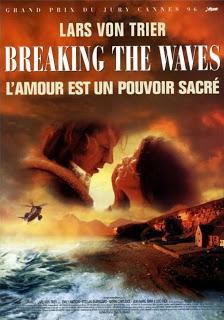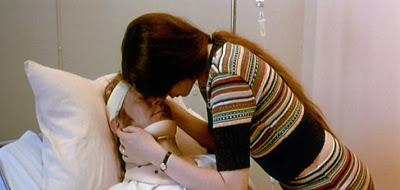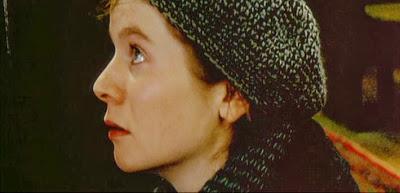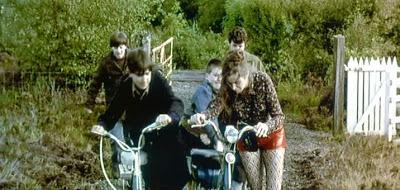 Lars von Trier’s Breaking the Waves is just amazing cinema.
Lars von Trier’s Breaking the Waves is just amazing cinema.It is essentially a film about the relationship of a newly married couple Bess (Emily Watson) and Jan (Stellan Skarsgard). It is an unusual film as it never really bothers to explain to the viewer how this couple met or decided to get married. For the director von Trier and his co-scriptwriter Peter Asmussen, those are not details of importance. For the director and his co-scriptwriter the film is all about the post-marriage events—not what led to the marriage. Even Bess’ sister-in-law Dodo (Katrin Cartlidge) who, we learn as the film unfolds, is the closest person to Bess and lives in the same house, states early in the film following the marriage that she does not know Jan well and that she hopes Jan would take good care of Bess. The viewer soon realizes that Bess is still a virgin right up to her marriage and that Jan too is totally devoted to his bride although they obviously never had sex before marriage, unusual details considering that they are so devoted to each other in a contemporary Occidental scenario. Those are some of the few quaint but important elements of the past about the duo that the scriptwriters reveal.

The marriage
The marriage takes up “Chapter One: Marriage of Bess”, which begins with an intriguing still life shot that soon deceptively comes alive with a helicopter appearing in the sky. On the soundtrack, you hear Mott the Hoople belting out his 1973 rock song All the way from Memphis, which is about losing his guitar (in real life) while traveling to Memphis. Soon the song stops halfway. Much later in the chapter you see Bess impatiently waiting in her wedding gown to greet Jan, who has just arrived from his workplace on the helicopter. The way von Trier uses this chosen piece of music as an intermezzo for his narrative is different and interesting. The director expects the viewer to rewind the film in his mind to pick up the connections. It’s not just rock songs that von Trier employs for his chapter breaks’ soundtracks. For “Chapter Five: Doubt”, the director employs the lovely folk song Suzanne written and sung by Leonard Cohen in 1966 with the words
Suzanne takes you down to her place near the river/
You can hear the boats go by/
You can spend the night beside her
And you know that she is half crazy
But that’s why you want to be there.
Long after the song fades away halfway, the movie presents the “half crazy” Bess trying to seduce Jan’s doctor in his apartment. Again the director expects the viewer to recall the phrases from the song heard a few minutes earlier in screen time to pick up the connections between the almost still life “chapter break” visual, the intermezzo song, and what follows as the narrative of the story within the chapter.

Post-marriage love
Breaking the Waves presents an unusual way to present a tale on screen.
First, while it is structured like a book complete with a prolog, chapters and an epilog, it extends the literary structure to references in contemporary rock and folk music, with lyrics that match the tale that follows within each chapter. Thus, when the chapter is over on the screen, the chapter title and the song add a second level of enjoyment /entertainment in an overt way. One could argue that all intelligent directors do the same when they deliberately choose a song or piece of music in a movie. However, unlike most other filmmakers, for von Trier the musical introduction is used as a precursor to what is to follow—unlike most other directors who would use the music synchronously with the visual tale. If one studies the structure of the film closely, the prolog of the film before Chapter One begins has Bess responding to the question of the elders of the church posed to her as to what Jan and his friends who are outsiders to the Scottish community have “brought of real value” with a simple answer: “Their music.” Those words do not make much sense to the viewer nor to the church with a bell tower and no bells in it make sense until the epilog of the film when the viewer hears glorious sound of the church bells ringing. The screenplay is well crafted. Somewhere in between the prolog and the epilog you see Jan and his colleagues are avid listeners of music on the oil rig. Somewhere in between Bess expresses her sorrow to see Jan depart for work by hitting an overhead crane with a metallic rod, and Jan responds by doing the same action and the sound communicates his love for his wife as no words could. That’s great cinema. You realize the importance of sound and music for the filmmaker in developing the film’s narrative.

Chapter break--rainbow and the church steeple
Second, the film is built around one word: “good.” An alert viewer will be surprised at how often that word is spoken in the film. And sometimes, the “good” aspects are highlighted by deliberately presenting the “bad” and calling it as such verbally. In the intermezzo of “Chapter Seven: Bess' Sacrifice” Pink Floyd sings
If you have been bad
Lord , I bet you have
and you have not been good..
The mesmerizing performance of Emily Watson includes the unforgettable “conversation” with God in a darkened church, with Watson employing her dramatic skills of creating the conversation by voice modulation and by underscoring the words “Now Bess, be a be a good girl.” The film develops a fascinating and sometimes thought provoking tale of what is good. It is an essay on being a good wife and conversely a good husband who is empathetic towards his spouse without thinking deeply of the consequences of his demands. In the epilog, the doctor who has been treating and guiding her post-marriage states at Bess’ inquest that her death was caused by being “good” rather than being psychotic or neurotic. While there are sufficient instances in the film to prove Bess is mentally unstable, the film goes beyond the medical condition to explore what is morally and spiritually considered good and, conversely, considered bad. Even Bess has an opinion of “good” in social terms when she says “I have always been stupid but I am good at this”

Post-accident love
Third, the film is quintessentially a film about love in all its myriad forms. There is carnal love. There is exceptional devotional love for God. There is sacrificial love for one’s beloved, in this case the spouse. There is platonic love expressed by Bess’ sister-in-law for her. The key words of Bess in the film as spoken to her doctor are “Jan and me have a spiritual contact. I choose for myself. To give Jan his dreams.. I don’t make love with them; I make love with Jan. And I save him from dying.” Jan himself acknowledges “Love is a mighty power.”

Love for God: conversing with God in a darkened church
Finally, the film is a debate on religion. The pious does seem to act in a way that results in a miracle after medical opinion is initially quite unsure of a positive outcome. It is a film about questioning the Church’s (is it Calvinist?) treatment of the dead who have obviously sinned while alive. Bess enters the packed Church midway into the film dressed as a prostitute and on hearing a part of the sermon shouts “How can you love a word? You cannot love words. You cannot be in love with words. You can love another human being. That’s perfection.” These are words that need to be put in context with the words of the priest at Bess’ wedding commending her love for God expressed by her selfless actions in keeping the same church clean over a long period. The script obviously parallels actions of Jesus, Mary Magdalene, and to some extent, Joan of Arc. The movie thus questions aspects of religion as much as it affirms it. To be more precise it is Lars von Trier’s personal look at what constitutes “good” in religion and in marriage.

The modern Mary Magdalene
And when Lars von Trier deals with “good” subjects he is more than a good filmmaker. The bells toll.
Any analysis of Breaking the Waves will be incomplete without praise for Emily Watson’s performance. Though this was the first regular movie role for her, it is sad that she was nominated for an Oscar and that she did not eventually win it. This is a spectacular film performance from a good stage actress (most of them give great turns in cinema by a rule of thumb). Perhaps von Trier should be congratulated on his casting skills and directorial skills in eliciting flawless performances from the entire cast. Lars von Trier can put some viewers off in some of his films but this one is a winner all the way. It could, despite its nudity and adult theme, even serve as a text for students of theology to mull over while discussing love, marriage and being “good” in the sight of God as much a medical case of analyzing neurosis/psychosis.
The film won the Cannes film festival’s Grand Prize of the Jury in 1996 and the European film awards for best film and best actress, awards that stand out among some 43 awards won by the film worldwide.
P.S. The movie is one of the author’s top 100 films.
<a href="http://feedjit.com/">Feedjit Live Website Statistics</a>

